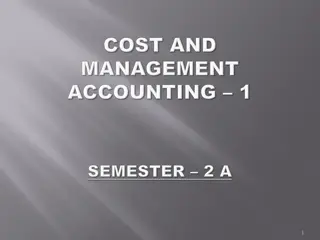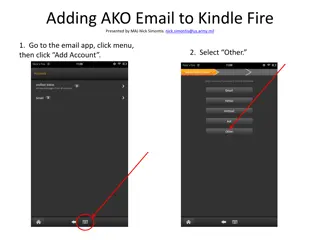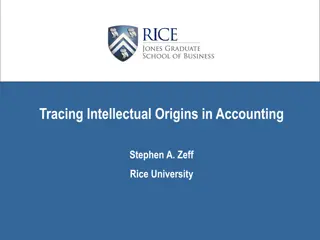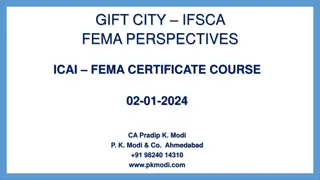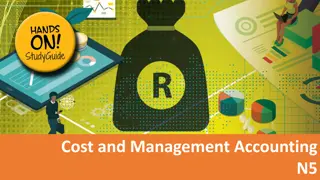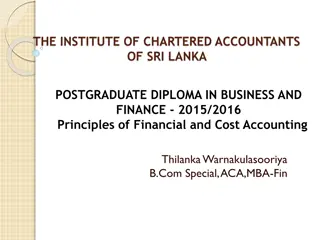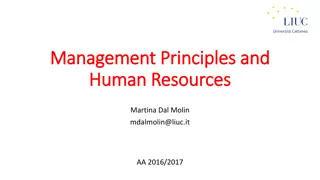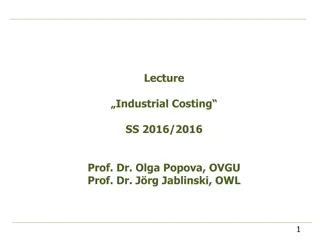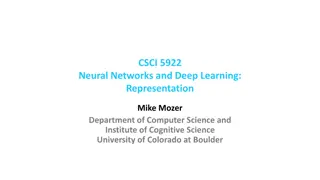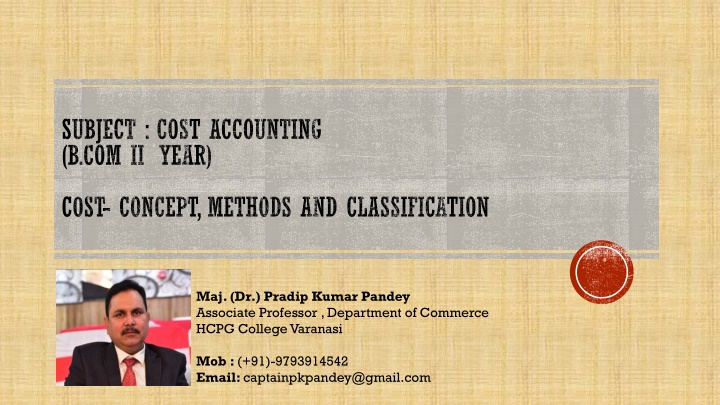
Cost Accounting: Concepts, Methods, and Classification
Explore the fundamental concepts of cost accounting, including cost vs. management accounting, elements of cost, classification methods, costing techniques, and more. Learn about cost centers, cost units, and various costing methods like marginal costing, job costing, and process costing.
Download Presentation

Please find below an Image/Link to download the presentation.
The content on the website is provided AS IS for your information and personal use only. It may not be sold, licensed, or shared on other websites without obtaining consent from the author. If you encounter any issues during the download, it is possible that the publisher has removed the file from their server.
You are allowed to download the files provided on this website for personal or commercial use, subject to the condition that they are used lawfully. All files are the property of their respective owners.
The content on the website is provided AS IS for your information and personal use only. It may not be sold, licensed, or shared on other websites without obtaining consent from the author.
E N D
Presentation Transcript
SUBJECT : COST ACCOUNTING (B.COM II YEAR) COST- CONCEPT, METHODS AND CLASSIFICATION Maj. (Dr.) Pradip Kumar Pandey Associate Professor , Department of Commerce HCPG College Varanasi Mob : (+91)-9793914542 Email: captainpkpandey@gmail.com
SYLLABUS : UNIT I Nature and Scope of Cost Accounting, Cost Vs. Management Accounting, Elements of Cost and their Classification, Methods and Techniques, Installation of Costing System, Concept of Cost Audit. Accounting for material: Material Control, Techniques, Pricing of material issues, Treatment of material losses. UNIT II Accounting for Labour: Labour Cost Control, Procedure, Labour Turnover, Idle Time and Overtime. Methods of Wage Payment-Time and Piece rates, Incentive Schemes. Accounting for Overheads: Classification and Departmentalization, Absorption of Overheads, Determination of Overhead rates, Under and Over Absorption and its treatment UNIT III Cost Ascertainment: Unit Costing Job Costing, Batch Costing, Contract Costing. UNIT IV Operating Costing, Process Costing, Cost Records: Integral and non-Integral System; Reconcilation of Cost and Financial Accounts.
KEY CONCEPTS Cost: It does not have a definite meaning and its scope is extremely broad and general. As per the Cost Accounting Standards of ICWA of India, it is defined as follows : Cost is a measurement, in monetary terms, of the amount of resources used for the purpose of production of goods or rendering services. Expenseis defined as an expired cost resulting from a productive usage of an asset. Lossis defined as reduction in firm s equity, other than from withdrawals of capital for which no compensating value has been received. COST EXPIRED COST UNEXPIRED COST EXPENSE LOSS SHOWN IN PROFIT AND LOSS ACCOUNT ON DEBIT SIDE SHOWN IN BALANCE SHEET AS AN ASSET
KEY CONCEPT Cost Centre: It refers to a section of the business to which costs can be charged. It may be a location( a department, a sales area), an item of equipment( a machine a delivery van), a person (salesman, machine operator) or a group of these. Cost centres are primarily of two types: 1. Personal Cost Centre: which consist of person or group of persons 2. Impersonal Cost Centre: which consists of a location or an item of equipment or group of these. From Functional point of view, it may be divided in two categories: 1. Production Cost Centre: It is a cost centre where actual production work takes place. 2. Service Cost Centre: It is cost centre which are ancillary to and render services to production cost services. Cost Unit: Costs units are the things that the business is set up to provide of which cost is ascertained. For example in a sugar mill, the cost per tonne of sugar may be ascertained.
METHODS OF COSTING: The method or types of costing refers to the methods employed in the ascertainment of costs. COSTING TECHNIQUES MARGINAL COSTING Cost data JOB PROCESS COSTING COSTING FACTORY JOB COSTING BATCH COSTING CONTRACT COSTING UNIT COSTING OPERATION COSTING SERVICE COSTING MULTIPLE COSTING COSTING METHODS
CLASSIFICATION OF COSTS: Classification is the process of grouping costs according to their common characteristics. It is a systematic placement of like items together according to their common features. There are various ways of classifying costs as given below: 1. Classification into Direct and Indirect Costs: It is on the basis of their identifiability with cost units or jobs or processes or cost centres. Direct Cost: These are those costs which are incurred for and conveniently identified with a particular cost unit, process or department. Cost of raw material used and wages of machine operator are common example of direct cost. Indirect Cost: These are general costs and are incurred for the benefit of a number of cost units, processes or departments. Depreciation of machinery, insurance, lighting, power, rent, managerial salaries etc. 2. Classification into Fixed, Variable and Mixed Costs: It is on the basis of behaviour or variability. Fixed Cost: These costs remain constant in total amount over a wide range of activity for a specified period of time, i.e. those do not increase or decrease when production volume changes. For e.g.. Building Rent Variable Cost: These cost tend to vary in direct proportion of the volume of the output. In other words if the volume of the output increases, total variable costs also increases Semi-variable or semi-fixed or mixed cost: These cost include both fixed and variable component. For example in telephone bills, there is a fixed cost for certain number of calls and then it is charged per call.
CLASSIFICATION OF COSTS: 3. Classification into Controllable and Non-controllable Costs: It is on the basis of controllability. Controllable Cost: These are cost which may be directly regulated at a given level of management authority. Variable costs are generally controlled by department heads. Non-controllable Cost: These are those costs which cannot be influenced by the action of the specified member of an enterprise. For example factory rent. 4. Classification into Normal Costs and Abnormal Costs: Normal Cost: It may be defined as cost which is normally incurred on expected lines at a given level of output. This cost is a part of cost of production Abnormal Cost: It is that which is not normally incurred at a given level of output. Such cost is over and above the normal cost and is not treated as part of cost of production. It is charged to costing Profit and Loss account.








